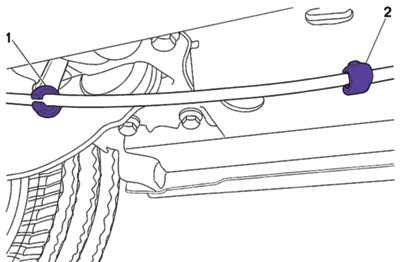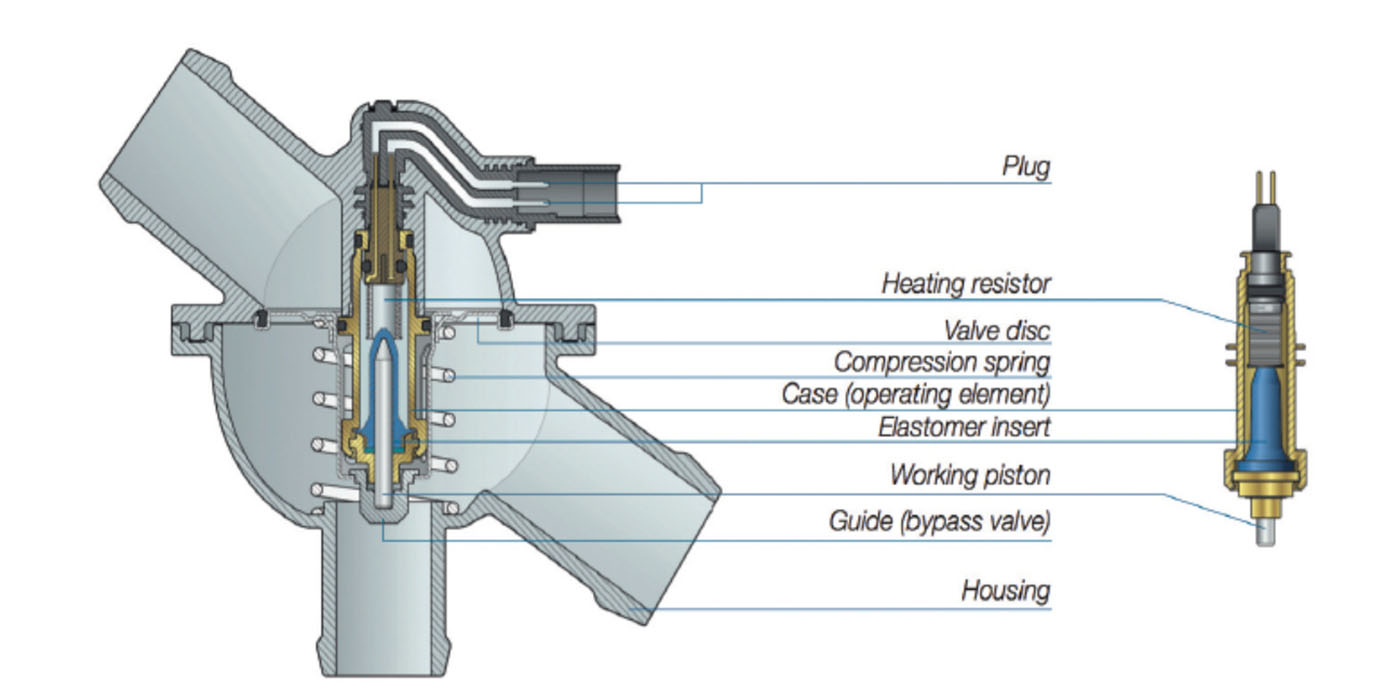
Models: 2005-‘07 Chevrolet Malibu (Sedan Only) with Rear Drum Brakes (RPO J41 or JM4)
Some customers may comment on a squeak or creak-type noise coming from the rear of the vehicle. This noise occurs at slow speeds while driving over small bumps and is most apparent when the underbody of the vehicle is wet. This condition may be caused by the parking brake cables rubbing or slip-sticking on the retainer grommet.
Correction
Replace both existing white parking brake cable grommets with new black grommets (P/N 15807015) using the procedure below. These new black grommets are made from a Teflon material.
• Raise and support the vehicle.
• Open the underbody clip (No. 2) to provide some slack in the parking brake cable. Use a flat-bladed tool to release the lock tab. Use care not to permanently bend the parking brake cable. If the cable becomes bent, it must be replaced.
• Remove the white grommet (No. 1) from the bracket. Pull the parking brake cable inboard, gripping the cable on both sides of the grommet.
• Use pliers to remove the white grommet from the cable.
• Line up the new black grommet slot with the cable and compress onto the cable using pliers.
• Install the black grommet into the bracket.
• Reinstall the parking brake cable into the underbody clip.
• Repeat the steps above for the other side.
Courtesy of ALLDATA
Toyota FJ Cruiser Water Pump Replacement
Toyota’s original Land Cruiser was the company’s version of a Jeep that could go anywhere. In its time it was highly rated and collected, which led the Japanese juggernaut to bring back an updated SUV in 2007 called the FJ Cruiser. The retro-styled vehicle was again a go anywhere machine powered by a 4.0L V6 (1GR-FE) used in the Tacoma. The engines are durable and considered relatively robust for the time.
Toyota’s original Land Cruiser was the company’s version of a Jeep that could go anywhere. In its time it was highly rated and collected, which led the Japanese juggernaut to bring back an updated SUV in 2007 called the FJ Cruiser. The retro-styled vehicle was again a go anywhere machine powered by a 4.0L V6 (1GR-FE) used in the Tacoma. The engines are durable and considered relatively robust for the time.
Long-Life Coolants Explained
Different types of coolants cover a range of applications from diesel to domestic, Asian and European vehicles. Each one is formulated to a specific manufacturer’s specifications to keep their engines at an optimal temperature. But, changes to the old one-size-fits-all formula has led to confusion for consumers and even some technicians.

VIDEO: Engine Efficiency Brings More Hoses
Andrew Markel discusses hoses and the necessity for several of them to route fluids to all parts of the vehicle due to the growing efficiency of engines. Sponsored by Dayco.

Diagnosing Intelligent Cooling Systems
The majority of cooling systems on the roads react to what is happening inside the combustion chamber. After the engine is stressed, the heat causes the thermostat to open. Increases in temperatures will also cause the cooling fans to come on. The heat carried by the coolant is the trigger for operation of the fans and thermostat.

Modern Cooling System Design: It’s Not About Temperature; It’s About Powertrain
Given the advanced state of internal combustion engine technology, some recent cooling system innovations will actually increase engine torque and fuel economy while reducing exhaust emissions. Let me simplify that idea: new cooling system technology will make engines run better and cleaner. So, let’s get on the same page by reviewing some basics.

Other Posts
Why Does Engine Coolant Need Replacement?
Two specifications can be used to justify replacement — the condition of the additive package & the freezing point.

Improving Turbocharger Longevity
It is estimated that by 2022, 50% or more of vehicles sold in the U.S. will have one or more turbochargers under the hood.

Engine Cooling System: Hose Inspection and Replacement
One bad hose can cause an engine malfunction. This video is sponsored by Continental.

Servicing Electronically Controlled Thermostats
When the heater circuit fails, most of the time it will create an open circuit.






